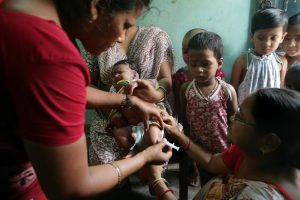Most people agree that there is only one way to stop the devastating second-wave of COVID-19 that is currently ripping through India: vaccinate as many people as possible. But the path to that goal seems fraught with several problems.
India has been struggling to procure enough vaccines, thanks to a combination of low upfront investment in capacity and poor planning. Earlier this year, India exported over 60 million doses of vaccines to countries all over the world. But as cases and deaths have piled up over the last couple of months, Indians now find that there are few vaccines left for themselves. Frustrated protesters were recently arrested in New Delhi, after they put up cheeky posters asking Prime Minister Narendra Modi why he sent their children’s vaccines away.
But supply constraints are not the only problem that Indians currently face. In order to get vaccinated, most people must register online on the government’s CoWIN website. Yet, in a country where only about a third of people have access to the internet, that requirement is already a huge class barrier. While some states have allowed walk-in vaccination appointments for a section of the population, most have not. Others have piloted such a policy and rolled it back, ostensibly due to supply shortages.
The shortage in supply and the requirement for online registration have combined to give rise to further inequality. Starting May 1, the government allowed those between the ages of 18 and 45 to get vaccinated. But with appointments fully booked in many cities, some city-dwellers settled for slots in nearby villages and small towns, where the digital divide and vaccine hesitancy have made it harder for local residents to book appointments.
The result is a widening gap between vaccination rates in cities and villages. While an estimated 30 percent of those in urban areas have received at least one shot of a vaccine, only about 12-15 percent of those in rural areas have had a dose. But over 60 percent of COVID-19 cases in India are now coming from the villages, which means that these low rural vaccination rates will allow the virus to spread further.
In a vast, densely populated, and poorly digitized country like India, this digitally dependent and relatively centralized vaccination strategy is ill-suited and counterproductive. Luckily, India has had much experience with mass vaccination in past decades – and plenty of lessons to draw from it.
Through the 1990s and 2000s, for instance, India managed to eradicate polio through intensive vaccination drives that inoculated over 100 million children each day. It was a simple recipe: A mass of volunteers were mobilized to go door-to-door in slums, villages, and remote dwellings, vaccinating every child they found. The government engaged at the grassroots with local community leaders, in order to tide over vaccine hesitancy and spread awareness about the disease as well as how it can be prevented. By 2011, India had officially become polio free.
The decentralized door-to-door polio drive provides a much more effective alternative, better suited to Indian conditions. It is wider reaching than the current approach, which depends on the internet and a handful of hospitals and vaccination centers to inoculate hundreds of millions of people. It is also more sensitive to COVID-19 protocols. In several cities across India, reports have shown that vaccination centers could themselves turn into hotspots, owing to heavy crowds and little social distancing. With door-to-door vaccination drives, that risk can be controlled and reduced.
Whatever approach India takes to vaccinating its people, there seem to be few shortcuts to the shortage of vaccines. But by laying out a proper blueprint, engaging with community leaders and setting up necessary infrastructure in rural areas right away, India can increase the pace of vaccination whenever doses become available. But for that to happen, India must do away with its urban-centric approach to beating COVID-19.
































